
The geometer moths are moths belonging to the family Geometridae of the insect order Lepidoptera, the moths and butterflies. Their scientific name derives from the Ancient Greek geo γεω, and metron μέτρον "measure" in reference to the way their larvae, or inchworms, appear to measure the earth as they move along in a looping fashion. Geometridae is a very large family, containing around 23,000 described species; over 1400 species from six subfamilies are indigenous to North America alone. A well-known member is the peppered moth, Biston betularia, which has been the subject of numerous studies in population genetics. Several other geometer moths are notorious pests.

The Macariini are a tribe of geometer moths in the subfamily Ennominae. Though they share many traits with the Sterrhinae, this is probably plesiomorphic rather than indicative of a close relationship, and DNA sequence data points to the Boarmiini as particularly close relatives of the Macariini. All things considered, this tribe might still resemble the first Ennominae more than any other living lineage in the subfamily.

Geometrinae is the nominate subfamily of the geometer moth family (Geometridae). It is strongly split, containing a considerable number of tribes of which most are presently very small or monotypic. These small moths are often a light bluish green, leading to the common name of emerald moths, though a few species called thus are also found in the tribe Campaeini of the Ennominae. In 2018, a phylogeny and classification based on a molecular phylogenetic analysis was published in the Zoological Journal of the Linnean Society in which 13 tribes were accepted.

The Cidariini are the largest tribe of geometer moths in the subfamily Larentiinae. The Cidariini include many of the species known as "carpets" or, ambiguously, "carpet moths", and are among the few geometer moths that have been subject to fairly comprehensive cladistic study of their phylogeny. The tribe was described by Philogène Auguste Joseph Duponchel in 1845.
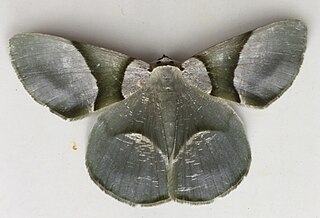
Calleremites is a monotypic moth genus in the family Geometridae. Its only species, Calleremites subornata, is found in China, Sikkim in India and Myanmar. Both the genus and species were first described by William Warren in 1894 and it has only been seen three times since then, the latest in a forest in northern Myanmar.

Cosmorhoe is a monotypic moth genus in the family Geometridae erected by Jacob Hübner in 1825. Its only species, Cosmorhoe ocellata, the purple bar, was described by Carl Linnaeus in his 1758 10th edition of Systema Naturae.
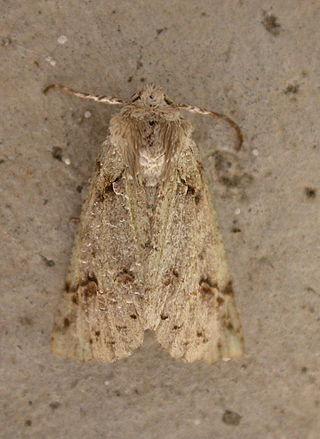
Declana is a genus of moths in the family Geometridae that is endemic to New Zealand. The genus was erected by Francis Walker in 1858.

Dyspteris is a genus of moths in the family Geometridae and was erected by Jacob Hübner in 1818. It is monotypic, being represented by a single species, Dyspteris abortivaria, commonly known as the bad-wing. This species was first described by Gottlieb August Wilhelm Herrich-Schäffer in 1855 and is found in North America.

Eois is a genus of moths in the family Geometridae. The genus contains about 250 validly described species, most from the Neotropical region. Many species are still undescribed and the total number of species is estimated to be over a 1,000 in the Neotropical region alone. The genus was first described by Jacob Hübner in 1818.

Euchoeca is a monotypic moth genus in the family Geometridae erected by Jacob Hübner in 1823. Its only species, Euchoeca nebulata, the dingy shell, was described by Giovanni Antonio Scopoli in 1763. It is found in the Palearctic realm, from Europe across Russia to Japan.

Eusarca is a genus of moths in the family Geometridae described by Jacob Hübner in 1813.
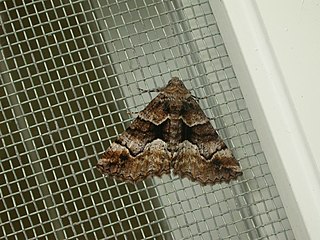
Gastrina is a monotypic moth genus in the family Geometridae. Its only species, Gastrina cristaria, the wave-lined geometrid, is found in the south-eastern quarter of Australia. Both the genus and species were first described by Achille Guenée in 1857.
Isoplenodia is a genus of moths in the family Geometridae. It formerly consisted of only one species, Isoplenodia arrogans, found on Madagascar, but new species were described in 2010.
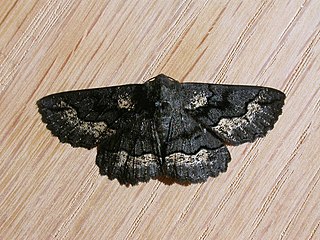
Melanodes is a monotypic moth genus in the family Geometridae. Its only species, Melanodes anthracitaria, the black geometrid, is found in Australia, more specifically in southern Queensland, New South Wales, Victoria, South Australia, and Tasmania. The genus and species were described by Achille Guenée in 1857.
Pamphlebia is a monotypic moth genus in the family Geometridae described by Warren in 1897. Its only species, Pamphlebia rubrolimbraria, was first described by Achille Guenée in 1857. It is found in Sri Lanka, Borneo, Indonesia, Taiwan and Australia.

Sterrhinae is a large subfamily of geometer moths with some 3,000 described species, with more than half belonging to the taxonomically difficult, very diverse genera, Idaea and Scopula. This subfamily was described by Edward Meyrick in 1892. They are the most diverse in the tropics with the number of species decreasing with increasing latitude and elevation.
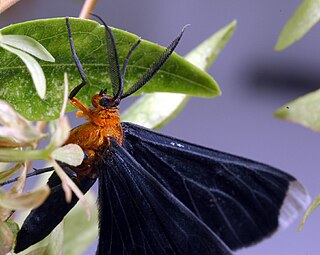
Melanchroia chephise, the white-tipped black or snowbush spanworm, is a moth of the family Geometridae. It is found from Florida and Texas, south to Paraguay. Strays have been recorded from Arizona, Oklahoma, Arkansas, Kansas and Illinois.

Herochroma baibarana is a species of moth of the family Geometridae first described by Shōnen Matsumura in 1931. It is found in China, Taiwan, Sri Lanka, the north-eastern parts of the Himalayas, Peninsular Malaysia, Sumatra and Borneo.
Louis Beethoven Prout (1864–1943) was an English entomologist and musicologist.
















